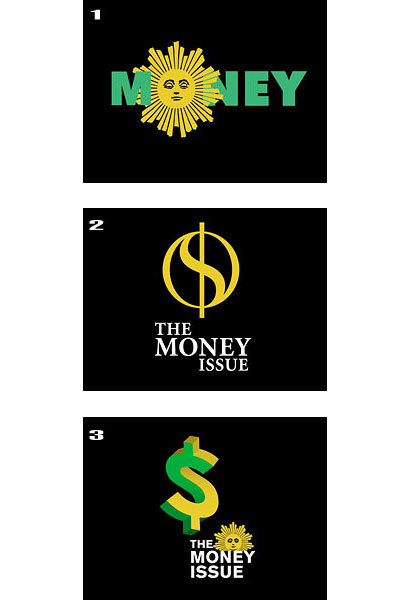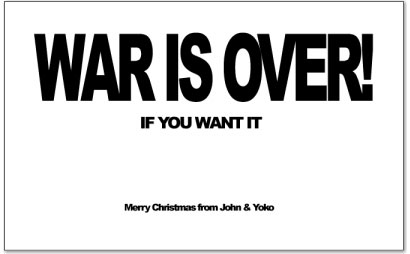The last thing one needs is undue media attention. The point when people know (or think they know) what you do is the point when you start getting the kind of random feedback which traditionally drives designers nuts.
Adding to the client psychotherapy that is part of our daily duties, is the increasing need to combat misconceptions which result from everyday media. For example, I was dumbfounded by Chevrolet’s recent Winter Olympic ad campaign which stated “America’s Brand Supports America’s Best” — not for their quality; but because they used the word “brand” so blatantly.
Since when does the American public know what branding is?
Along with general public discourse on box office receipts, cooking and political campaign strategies, we have recently seen televised exposés on fashion, bounty hunting and now, logo design.
Yesterday morning, the program CBS News Sunday Morning aired their “Money Issue”. Among stories about businessmen, corporate philanthropy, personal debt and retirement, correspondent Russ Mitchell went “behind the draft boards to find out how logos are made.”
In the segment, a team from C&G Partners (including Steff Geissbuhler, Emanuela Frigerio, and Jonathan Alger) designed a logo for “The Money Issue” while Steve Heller discussed their methodology as well as the cultural effect of corporate logos. The C&G team only had three days to come up with a presentation and it was noted that they were not going through the research and preparation stages usually required before sketching.
After individual work, group critiques and explorations of animation possibilities, C&G whittled it down to three choices.

The proposals were not presented on air. To see them, viewers were instructed to visit the Sunday Morning website — where they could vote for their favorite. No discussion about why they were selected above all the other designs; no discussion about iconography, intent nor context. Nothing.
Except the promise to reveal the winner next Sunday Morning.
Most see the designer as a set of hands — a supplier — not as a strategic part of a business. Their background is primarily marketing, purchasing, or advertising; only incidentally or accidentally are they connoisseurs of design. It is their uninformed, unfocused preferences or prejudices, their likes or dislikes, that too often determine the look of things. Yet they may not even be discriminating enough to distinguish between good and bad, between trendy and original work, not can they always recognize talent or specialized skills. They have the unique privilege, but not necessarily the qualifications, to judge design.
— Paul Rand Design, Form, and Chaos
By the nature of presentation, CBS’s logo exercise — as well as Target’s imprimatur of “design” — cannot convey enough to make any designer comfortable. Design is a practice based in doubt. Doubt about form, meaning, context, personal reputation, the competition, intent, and production mean the most minor decisions can require excruciating deliberation. Much too vague for a five-minute segment.
So for immediacy’s sake, the general public is offered soundbites about companies burning through lots of cash in the creation of logos and advertising platitudes. Design inspires… Design shapes… Design shines… But rather than rail against the injustice of surface interpretations, perhaps we should attempt incorporating everything we’ve come to hate about them into our strategy.

It sounds perverse enough to be useful. Or at least keep in mind that no longer how specific, how clear, how focussed you are; it’ll be something totally different in the end. Or maybe not. Oh damn, I wish I was smart enough to read Foucault properly.
The sagacity of the commentators is not mistaken: from the kind of analysis that I have undertaken, words are as deliberately absent as things themselves; any description of a vocabulary is as lacking as any reference to the living plenitude of experience. We shall not return to the state anterior to discourse — in which nothing has yet been said, and in which things are only just beginning to emerge out of the grey light; and we shall not pass beyond discourse in order to rediscover the forms that it has created and left behind it; we shall remain, or try to remain, at the level of discourse itself. Since it is sometimes necessary to dot the ‘i’s of even the most obvious absences, I will say that in all these searches, in which I have still progressed so little, I would like to show that ‘discourses’, in the form in which they can be heard or read, are not, as one might expect, a mere intersection of things and words: an obscure web of things, and a manifest, visible, Coloured chain of words; I would like to show that discourse is not a slender surface of contact, or confrontation, between a reality and a language (langue), the intrication of a lexicon and an experience; I would like to show with precise examples that in analysing discourses themselves, one sees the loosening of the embrace, apparently so tight, of words and things, and the emergence of a group of rules proper to discursive practice. These rules define not the dumb existence of a reality, nor the canonical use of a vocabulary, but the ordering of objects. ‘Words and things’ is the entirely serious title of a problem; it is the ironic title of a work that modifies its own form, displaces its own data, and reveals, at the end of the day, a quite different task. A task that consists of not — of no longer treating discourses as groups of signs (signifying elements referring to contents or representations) but as practices that systematically form the objects of which they speak. Of course, discourses are composed of signs; but what they do is more than use these signs to designate things. It is this more that renders them irreducible to the language (langue) and to speech. It is this ‘more’ that we must reveal and describe.
— Michel Foucault The Archaeology of Knowledge
This book first arose out of a passage in Borges, out of the laughter that shattered, as I read the passage, all the familiar landmarks of my thought — our thought, the thought that bears the stamp of our age and our geography — breaking up all the ordered surfaces and all the planes with which we are accustomed to tame the wild profusion of existing things, and continuing long afterwards to disturb and threaten with collapse our age-old distinction between the Same and the Other. This passage quotes a “certain Chinese encyclopedia” in which it is written that “animals are divided into: (a) belonging to the Emperor, (b) embalmed, (c) tame, (d) sucking pigs, (e) sirens, (f) fabulous, (g) stray dogs, (h) included in the present classification, (i) frenzied, (j) innumerable, (k) drawn with a very fine camelhair brush, (1) et cetera, (m) having just broken the water pitcher, (n) that from a long way off look like flies”. In the wonderment of this taxonomy, the thing we apprehend in one great leap, the thing that, by means of the fable, is demonstrated as the exotic charm of another system of thought, is the limitation of our own, the stark impossibility of thinking that.
— Michel Foucault The Order of Things : An Archaeology of Human Sciences
In using the coinage “logophobia”, I’m applying the Stoic definition of “logos”: a method or principle of generating specific seminal reasons (logoi spermatikoi) from which individual things are described. Nietzsche quotes Stendhal: “To be a good philosopher, one must be dry, clear, without illusion. A banker who has made a fortune has one character trait that is needed for making discoveries in philosophy, that is to say, for seeing clearly into what is.” (“Pour �tre bon philosophe, il faut �tre sec, clair, sans illusion. Un banquier, qui a fait fortune, a une partie du caract�re requis pour faire des découvertes en philosophie, c’est-�-dire pour voir clair dans ce qui est.”)
Being one of the most “phobic” when it comes to mass-media definitions of design, I’m attempting to wrap my brain around the possibility that there may be something of value in what, at the surface, appears to be a bullshit exercise — like the Sunday Morning logo contest. As in the Chinese encyclopedia, the media isn’t exactly wrong in their definition — only different. And from that difference comes meaning.
This isn’t to say that I’m perfectly happy with the portrayal of design on Sunday Morning, Target ads, The Apprentice, et al. In the specific case of the Sunday Morning logo story, I felt some cognitive dissonance between C&G Partners’s professionalism (ties, neat office, organized crit board) and their casual comments. Now, casualness of speech and interaction are important in a creative environment to encourage uninhibited participation. But how often do we see people in business dress speaking this way on television? Outside of situation comedy, that is.
Heller, on the other hand: articulate and surrounded by books; both consistent with each other, and with the preconceived notion of an author.
Frankly, these perceptions are my hang ups: idiosyncratic and limiting. Misconceptions are a gift. They’re a reality check and they describe the discourse. The challenge is finding value in these “Chinese” definitions; in the portrayal of design to clients and to the world. I have vague thoughts about design strategies which combat preconceived notions — avoiding the search for the “magic” typeface, diffusing inflated expectations, etc. — but that’s going to take a while. Yet I’m certain about one thing: reporters will most likely get it wrong. So, keep it simple.







Mark, I'm not sure if I really understand this post, so I am looking forward to reading what the discussion by persons more intelligen than me brings to light. However, I must say that the system of animal classification from a 'certain Chinese encyclopedia' is the best, most inspiring thing I've read in at least a week.
On Feb.27.2006 at 08:45 AM